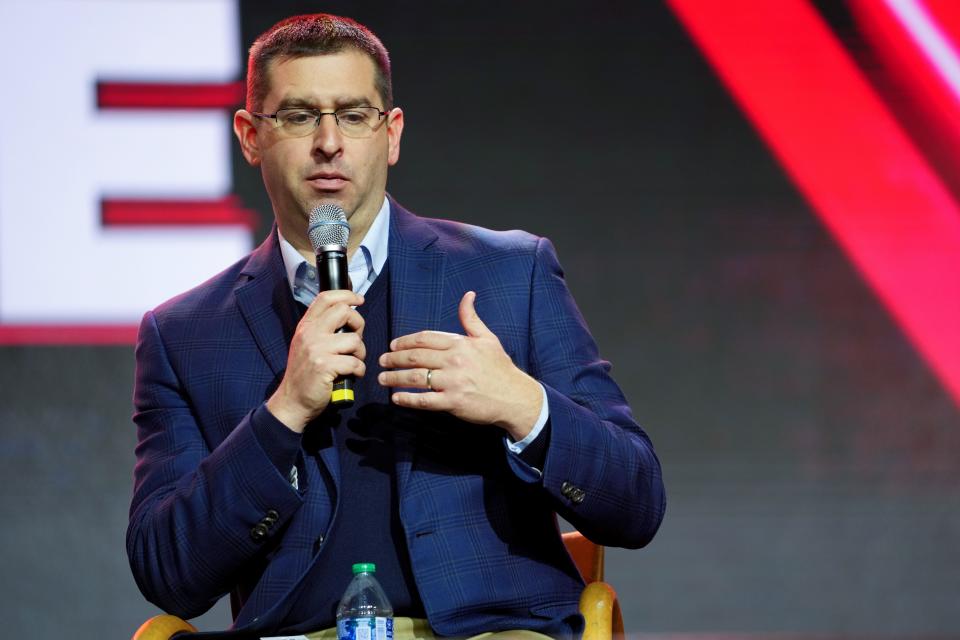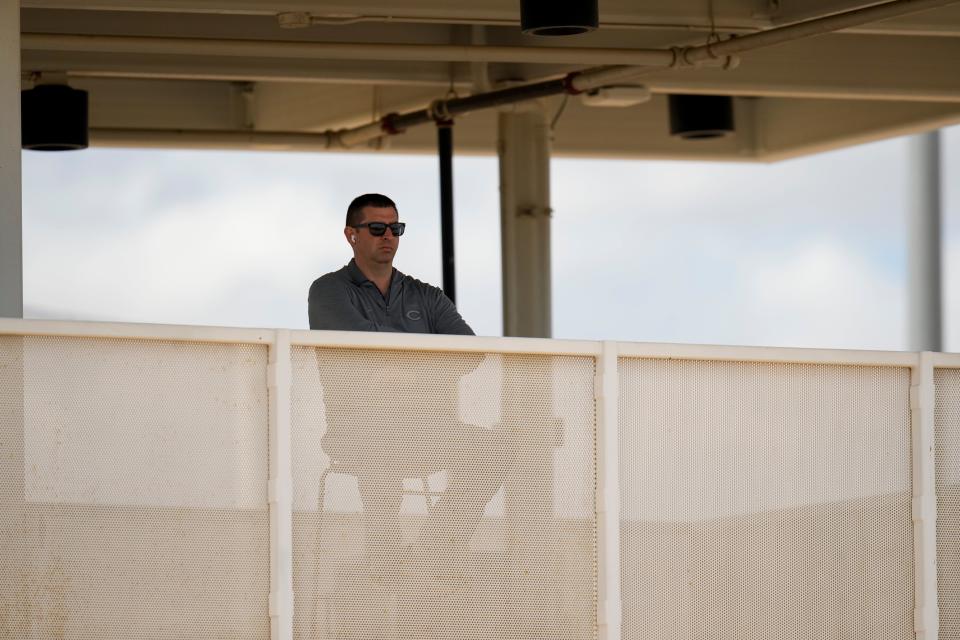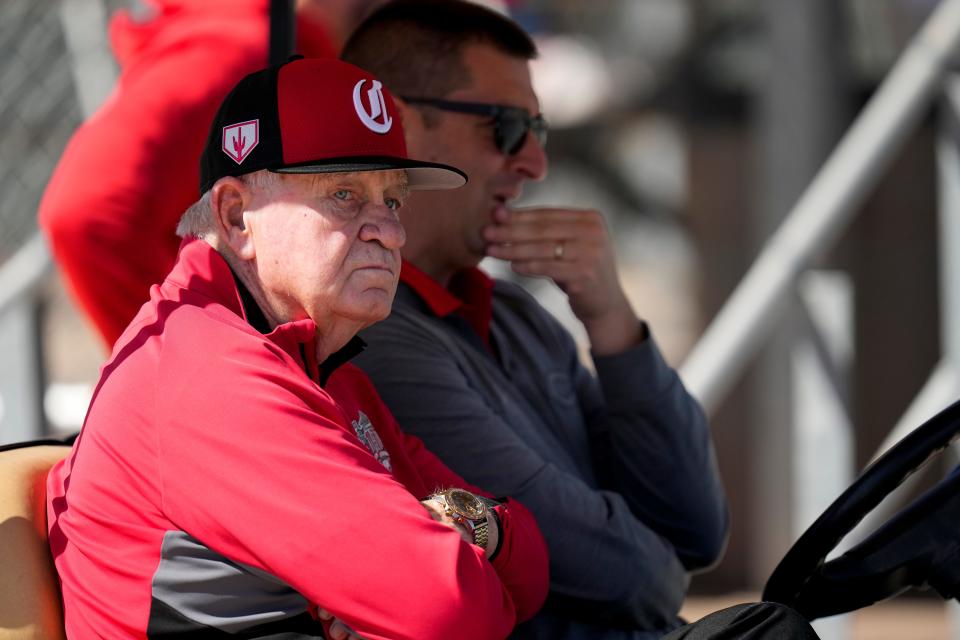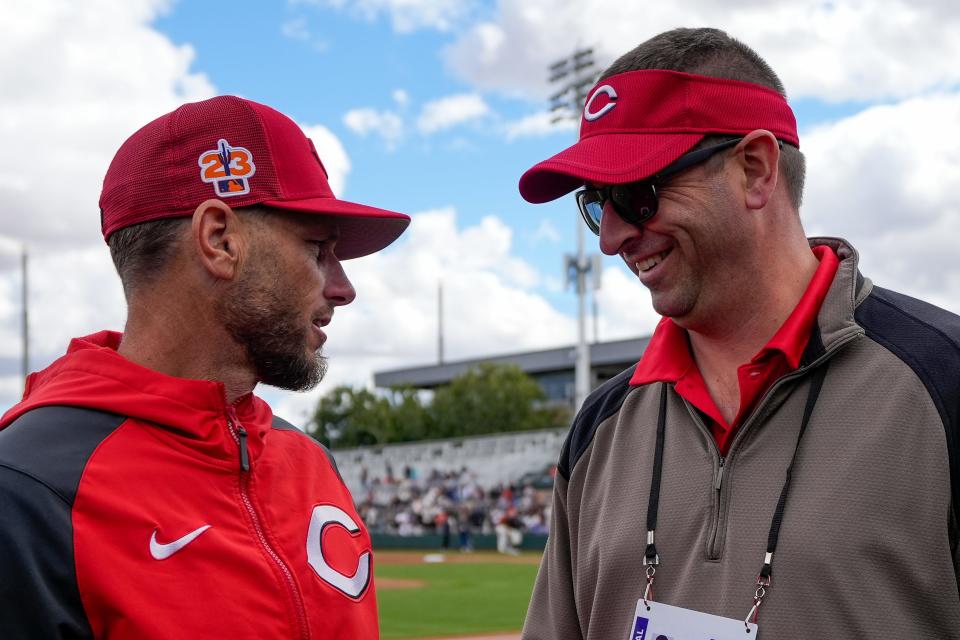Nick Krall Q&A: Reds' GM says 'You never know what their ceilings are'
Heading into Opening Day, Cincinnati Reds general manager Nick Krall participated in a Q&A with The Cincinnati Enquirer. He spoke about his vision for the Reds, the timeline for the Reds’ top prospects and why the Reds’ young core at the big league level deserves more attention.
You’ve spoken a lot about the plan of building through the farm system. How far ahead do you plan? What are the differences in preparing for three months from now versus five years from now?
There’s an overall vision. We’re trying to build from within and build a young core and continue to keep a good minor league system to continue to supplement that young core at the big league level. Three months from now, each player has their own goals. It’s trying to figure out what those individual plans are and how we can help those players move forward.
Does planning start with looking at the vision for five years from now, or does it start with what you have now shaping your long-term vision?
It does start right now. The overall theme of what we want to do is build from within.
If we have a good player pipeline year after year and continue to produce talent for the major league level, our big league clubs will continue to be good. That’s how we get sustained success. That’s what it starts with. We want to know what we’re pointing to. Our end goal is sustained success. We want to be successful year in and year out, and that starts with a successful farm system.

Are the prospects on their own timelines, or are they connected to openings that could come up on the big league roster?
We need players to continue to develop. They’re going to develop at their own speeds whether it’s in A-ball or Triple-A. Each player has different things they need to work on individually. We need to make sure we’re not looking at this as a cookie cutter system. We have to be able to individualize plans and programs for each player to maximize their development and their potential at the big league level.
How will you decide when Elly De La Cruz, Christian Encarnacion-Strand and Matt McLain will be ready for the big leagues?
You’ve got Matt McLain, who has played a full season at Double-A. Elly De La Cruz has played two months in Double-A. Christian has roughly 200 plate appearances. They’re all on different timelines. Some guys have got to figure out how to chase out of the zone less. Some guys have got to figure out how to make contact better. Some guys have to play better defense. Some guys are moving to a new position and are learning that.
It’s different for each guy. I really don’t want to put a timeline on it because it’s all about how these players are. We’ll evaluate them every day. We’ll see what that progress is. We’ll look at it from a person-by-person standpoint.
The farm system has nearly entirely turned over in just two years. Why has that been the case? Is that a good sign for how much the system has improved?
I look at our Daytona (Low-A) club. It has the potential to have five guys in the infield who all have a chance to be legitimate big league players. You have Cam Collier and Sal Stewart out of the draft. You have Leonardo Balcazar and Carlos Jorge out of the international market. You have Victor Acosta coming from a trade.
We’ve made a focus from drafting, international and the trade market to improve our athleticism at the minor league level. Whether a guy comes in as a shortstop doesn’t mean he’ll be a shortstop moving forward. Look at Noelvi Marte. He’s moving to third base. The more athletic you are, the better you’ll be at the corners whenever you get there. We want to have a good defense at all positions.
Getting the most athletic guys who can play defense in the middle of the diamond should translate to the corners as well. Some guys drafted before, who didn’t reach their potential, we have moved on from them. That’s always the case and you bring in another talented group of players. We have been focused on high-caliber athletic players who can hit.

On the major league side, there has been a ton of roster turnover over the last four seasons. Is the goal to have less roster turnover going forward?
Yes. I’d love to have players that are on our club and continue on our club. We made some trades over the last couple of years, we’ve had some free agents not come back for one reason or another. We’re continuing to build through our farm system. We can have these young players who can come up through our system and be on our major league team, that’s what we’re trying to do.
You have the starting pitching trio of Hunter Greene, Nick Lodolo and Graham Ashcraft. What can the organization do with that trio and how instrumental are they in your vision for the Reds?
It’s continuing to have good players in the minor leagues who can move up through the big leagues. When we talk about the minor leagues, I’m really excited about our young players in the big leagues. It’s the three guys that we’ve talked about in the rotation. It’s Alexis Díaz, who made his debut last year.
It’s Tyler Stephenson and Jonathan India, who made their debuts two years ago. It’s guys that are taking more of a prominent role. Jake Fraley had a good spring and is taking good steps forward. TJ Friedl earned a spot last year at the end of the year. We traded for Will Benson, and he just has 66 days of big league service.Watching the young players at the major league level, those guys continue to develop. You never know what their ceilings are. Some of these guys are going to reach their ceilings and have a really good career. For us, it’s about all those young players.

Is that why you’re most excited about the future, because you have a core of guys who have produced at the big league level?
That is the base for creating sustained success. The players in the big leagues have done it. Do they have room in their development to go? Yeah. Will they have some growing pains? Of course they are. When you have those young guys, people keep talking about our farm system. But we had a good farm system a couple of years ago and it was Lodolo, Ashcraft, Greene and guys like that. India won Rookie of the Year. Tyler Stephenson got Rookie of the Year votes.
These guys are young players on our big league club. It creates a really good core for guys to come up and be integrated into that core.
This spring, some standout young players across MLB have been given contract extensions. What’s your philosophy on giving contract extensions to young players?
We take it one person at a time. Is there a match here? Is there something we can do? We explore every option, and what that option is, whether it’s long-term or short-term, we should have conversations about every option for what we can and can’t do. I don’t have a strict philosophy that we’d do this here and here. It’s individual by individual.
Is there any lesson from the challenges you faced last year that have reshaped your approach and your philosophy as a GM?
People ask you, do you have any regrets in life? It’s a general question. We all look at life experiences, and they shape who we are moving forward. We have no regrets doing this or that. You learn different things.
I don’t have any regrets. Anything that you did, anywhere you feel you made a mistake, you learn from it. You learn lessons your whole life. You learn lessons from when you're 8 years old to when you’re 45. You keep learning. That’s a big part of who we are. Keep learning and keep adapting.

I’ve said this in the past. We need to make sure that we’re keeping our players and being smart about what we’re doing to try to develop our players. How we can have continuity. Continuing to hone that and develop that.
You might have made a mistake over here. You fix it and move on. You can’t dwell on it or complain about it. You have to learn from your mistakes, whatever they were, and move forward. Those mistakes shape who we are and how we can be the most productive.
Whether it’s a player who struggles with a strikeout and figures out how to lay off the breaking ball. Whether it’s us making a move at the front office level that doesn’t pan out. Did we have a good process? Why did we make the decision in the first place? I think we have to continue to have a good process and move on from our mistakes. That’s how we’re going to continue to grow and move forward.
When Kyle Farmer got traded, he said that outsiders don’t realize how much players want to be in Cincinnati. How and why have you created that type of culture?We want players to be here and come to work every day and do the best they can. We want staff to come here and say they’re really excited to be here. If you’re your best self, you’ll produce your best results.
Whether it’s players or staff, we want people to be with our organization. If there are issues with an organization, we’ve got to make changes because we want people to be here. We know that our scouting, analytics and player development staff, those people will be very important in trying to do what we’re doing and creating that sustained success model.
For example, we let a lot of our guys, trainers and strength coaches go to the World Baseball Classic this year. It’s an experience that they get to experience. It helps them grow as people.
We want to create a culture where it is a learning environment. It is a culture. If you keep doing what’s best for you and keep learning, you’ll do what’s best for the organization.
When you have those people come in and they’re doing really good work and you’re helping them grow, people around them see that they want to do that. They want to help me, too. You want everyone to be in that boat.
This article originally appeared on Cincinnati Enquirer: Nick Krall Q&A: Reds' GM says 'You never know what their ceilings are'

